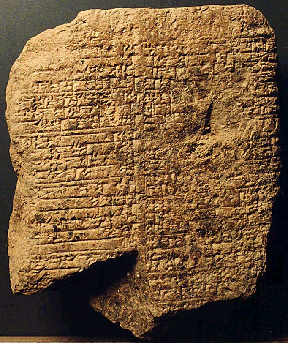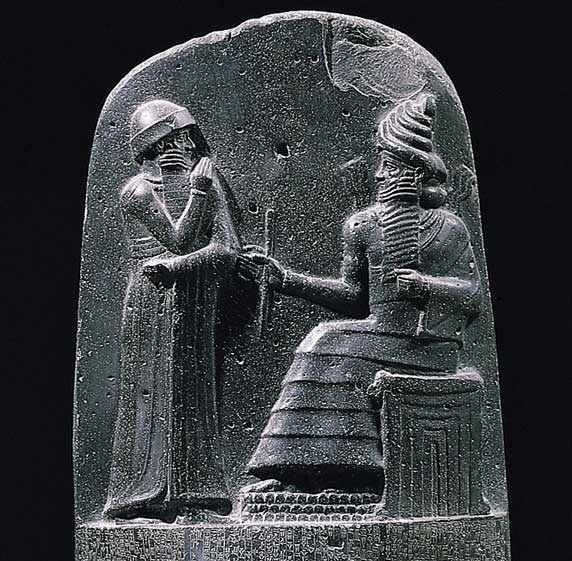*History 8 Mesopotamia Notes
Return to Main Page History 8
Contents
- 1 1. What is the legitimation of authority ?
- 2 2. How was it practiced in Sumer?
- 3 3. How are bureaucrats, writing and the calendar connected?
- 4 4. Define Polytheism.
- 5 5. Was there a belief in the afterlife in Sumerian religion?
- 6 6. Define law and give its three characteristics.
- 7 7. What is Lex talonis?
- 8 8. How did the monarchy change during the Old Babylonian period?
- 9 9. Hammurabi's Code reflected a change in law. What was that change? Why important ?
- 10 10. What group was forced to move from Judah to Babylon? What was their social status?
- 11 11. How was the Semitic domination of Mesopotamia ended?
- 12 12. Why are the Hittites one of the most significant peoples in Mesopotamian history?
- 13 13. How did law change?
- 14 14. What was the Assyrian policy toward conquered peoples and what was the result of this policy?
- 15 15. How do we know about Mesopotamian culture, myth and literature?
- 16 16. What were some of the innovations in warfare begun by the Assyrians?
1. What is the legitimation of authority ?
2. How was it practiced in Sumer?
Legitimation of authority was crucial to Sumer because it was a factor in uniting the first states in history. The Sumerian king was at first a king/priest, who was the leader of the government and also the leader of the religion. This was important to the king, as it allowed him to assert that he was chosen by divine selection. As time progressed, the Sumerians started to claim that he was divine himself, and that he was worthy to be worshiped. The Sumerians answered the question - Who deserves to have authority, and why? by claiming that their king was divine, sent by the gods to be their leader.
File:Http://association.tarotstudies.org/images/35aking.jpg
Citation: [1]
MLA Format:
Beniretto, Rosie. "Sumerians." Mesopotamia. St. John's School, 10 Nov. 2012. Web. 14 Nov. 2012. <http://www2.sjs.org/Beniretto/Mesopotamia/textcomputerexercise.html>.
External References:
The Sumerians - http://mesopotamia.mrdonn.org/sumer.html
Mesopotamian Government - http://mesopotamia.mrdonn.org/government.html
3. How are bureaucrats, writing and the calendar connected?
By Nina Lahoti
Bureaucrats, writing and the calendar are connected through the Sumerians, as they were all created by the Sumerians. They are also connected as bureaucrats required record-keeping, which required writing, and all of this administration required planning, so the calendar was made.
The bureaucrats, often called one of the best inventions ever made, was used for record-keeping whilst distributing things.
Writing was done in cuneiform, also known as wedge-shaped writing, which is the language that has been used for the longest time, other than Chinese.
The calendars were divided into twelve months based on the phases of the moon, and they illustrated the Sumerians' knowledge of astronomy.
4. Define Polytheism.
According to www.dictionary.com, polytheism is the "belief in more than one god or in many gods". Polytheism was first practiced by the Sumerians.
Works Cited
http://dictionary.reference.com/browse/polytheism?s=t
Abigail Moorhead
5. Was there a belief in the afterlife in Sumerian religion?
The Sumerians Believed in the afterlife. The tale of Gilgamesh is centered around finding everlasting life because, like Christians, the Sumerian afterlife was a grim place. They saw the afterlife as another life, like a life on earth. They created mummification to ensure a better time in the afterlife. However, the believe that the gods did not occupy some world existentially different from this one, and no rewards or punishments accrued to human beings after death. Human beings simply became wisps within a house of dust; these sad ghosts would fade into nothing within a century or so.
Zoroaster, one of the first to present the idea of one god, believed that those who were good went to a place of paradise and those who were bad went to a fiery hell.
 [2]
http://www2.sjs.org/Beniretto/Mesopotamia/textcomputerexercise.html#Sumerians
[2]
http://www2.sjs.org/Beniretto/Mesopotamia/textcomputerexercise.html#Sumerians
Picture from The British Museum Website.
Julian Chazz Nicholas Peavy
6. Define law and give its three characteristics.
Definition
Law is written and administered retribution and conflict resolution.
Characteristics
- Administration: Law is retribution that is administered by a centralized authority. This means that the punishment does not turn into revenge.
- Writing: Law is written; law assumes an independent character beyond the centralized authority that administers it. This makes sure that the law makers and the law administrators are not exempt from the law.
- Retribution Law is at heart revenge; the basic cultural way for dealing with bad behavior is to exact revenge.

Sources
http://www2.sjs.org/Beniretto/Mesopotamia/textcomputerexercise.html#SumerianLaw visited 11/13/2012,
http://schema-root.org/region/middle_east/iraq/national_library/ picture, viewed 11/13/2012
- Emily Pedrick
7. What is Lex talonis?
Lex talonis, basically law as retaliation, is the basis for Old Babylonian law. The phrase: "an eye for an eye, and a tooth for a tooth" shows the exact, and very harsh, penalties in Lex talonis, or the Law of Talon. For every offense, there was an equal counter punishment. For example, if someone killed someone else's mother, the other person would kill that persons mother for revenge. Lex talonis comes from Latin: "Lex" meaning "law" and "talonis" meaning retaliation. It is very common in more modern times too, as well as back then, reflected through Hammurabi's Code.
Sources:
http://www.wordiq.com/definition/Lex_talionis http://www.wordsmith.org/words/lex_talionis.html http://www2.sjs.org/Beniretto/Mesopotamia/textcomputerexercise.html#SumerianLaw
- Arisa Sadeghpour
8. How did the monarchy change during the Old Babylonian period?
In order to justify the enormous powers that the Babylonian monarch had, the Old Babylonians believed that their monarch was a god, and that he had a divine origin. This was a significant change in government. The new monarchy created new ways to run the state and its resources, such as taxation and military service. The greatest innovation that came with this government was centralization, where the monarch controlled all.
Manual Page 87
 ]
]
http://www.thelatinlibrary.com/imperialism/notes/hammurabi.html
-Sam Schneider
9. Hammurabi's Code reflected a change in law. What was that change? Why important ?
10. What group was forced to move from Judah to Babylon? What was their social status?
11. How was the Semitic domination of Mesopotamia ended?
The Babylonians had previously overthrown the Assyrian empire. After the fall of Assyria, Nebuchadnezzar rebuilt the city of Babylon. However, throughout the city, there were still people loyal to the Assyrians. In 555 BC, the Babylonian Empire came under the rule of Nabonidus, a king loyal to the Assyrians. Nabonidus attacked the Babylonian culture, placing the Assyrian moon-god, Sin, above the Babylonian's principal god, Marduk, who symbolized the faith and people of Babylon. [1] The people faithful to Babylon became enraged, allowing the Persian king, Cyrus, into their city, ending the Semitic domination of Mesopotamia. [2]
Nabonidus, the last king of Babylon (555-539 BC)
Sources:
- ↑ CF Manual Pg. 90
- ↑ http://www.livius.org/ct-cz/cyrus_I/babylon01.html
- ↑ http://www.mesopotamia.co.uk/ziggurats/explore/cylinder.html
By Jeffrey Wang
12. Why are the Hittites one of the most significant peoples in Mesopotamian history?
The Hitties are one of the most significant peoples in Mesopotamian history because of their empire. Because their empire was so large and because their primary activity was trading with all the civilizations and peoples of the Mediterranean, the Hittites were primarily responsible for transmitting Mesopotamian thought, law, political structure, economic structure, and ideas around the Mediterranean. The Hittites are the great traders in the culture and adopted and modified by later peoples. Information from the Class Lecture.
Sophie Worscheh
13. How did law change?
Law started with the Sumerians around 5000 BCE
sources: http://www2.sjs.org/Beniretto/Mesopotamia/textcomputerexercise.html#SumerianLaw http://mesopotamia.mrdonn.org/sumer.html
14. What was the Assyrian policy toward conquered peoples and what was the result of this policy?
15. How do we know about Mesopotamian culture, myth and literature?
The monarchs of Assyria, who hated Babylon with a passion since it constantly contemplated independence and sedition, destroyed that city and set up their capital in Nineveh. Later, however, feeling that the Babylonian god, Marduk, was angry at them, they rebuilt the city and returned the idol of Marduk to a temple in Babylon. The last great monarch of Assyria was Ashurbanipal (668-626 BC), who not only extended the empire, but also began a project of assembling a library of tablets of all the literature of Mesopotamia. Thirty thousand tablets still remain of Ashurbanipal's great library in the city of Nineveh; these tablets are our single greatest source of knowledge of Mesopotamian culture, myth, and literature.
http://www2.sjs.org/Beniretto/Mesopotamia/textcomputerexercise.html#AssyriaReligion Jasmine Williams
